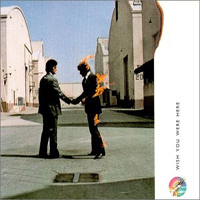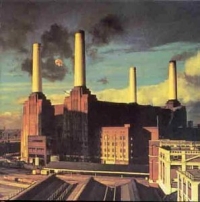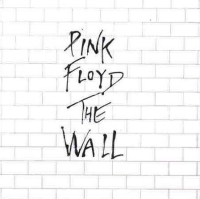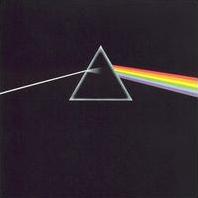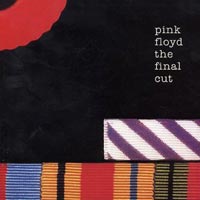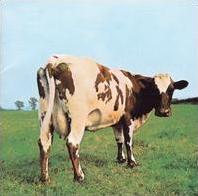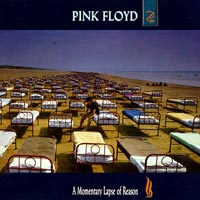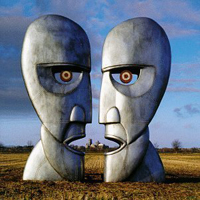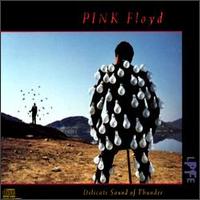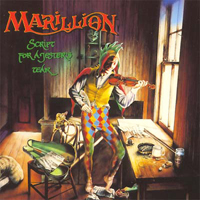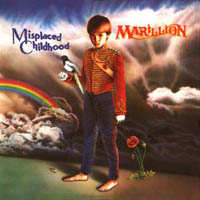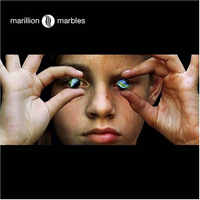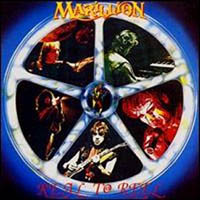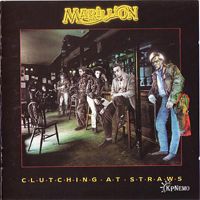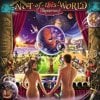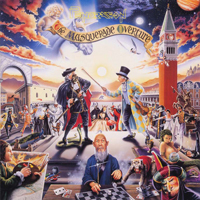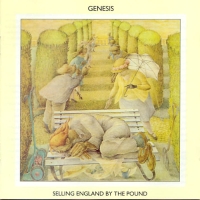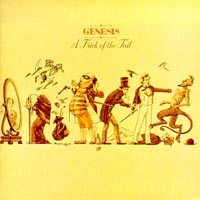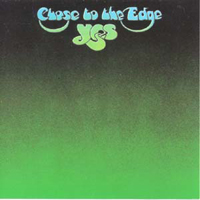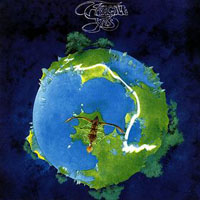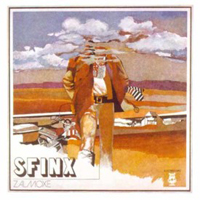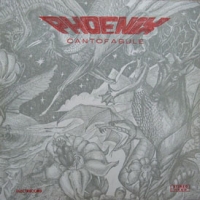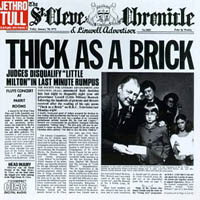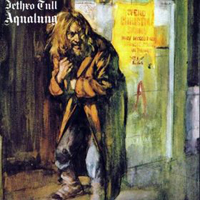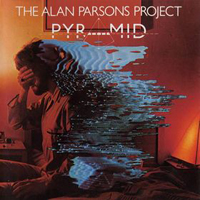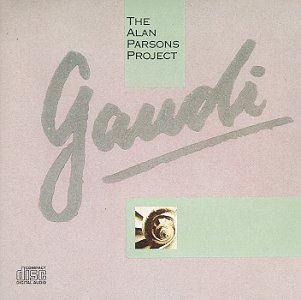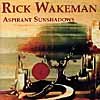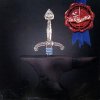Before I get to the first part of "Tigers," I'd like to address the non-Floyd song vaguely heard in the background of the movie's opening section. It's called "The Little Boy That Santa Claus Forgot," by Vera Lynn (see "Vera" later in this analysis; you can also click here to listen to Vera's rendition of this song in full). The lyrics are as follows: "Christmas comes but once a year for every girl and boy/ The laughter and the joy/ They find in each new toy./ I tell you of the little boy who lives across the way/ This fella's Christmas is just another day..."  At this point, the vacuum cleaner whirs into electric life and "When the Tigers Broke Free, Part 1" begins. After the song ends and we get that wonderful close-up of the Mickey Mouse watch, Vera's song continues with : "He's the little boy that Santa Claus forgot/ And goodness knows, he didn't want a lot./ He sent a note to Santa, what he wanted was a drum/ This broken little heart when he woke and he hadn't come/ In the streets, yes he..." Once again, the vacuum drowns out the song. From the outset, Waters sets up a few brilliant parallels that will recur throughout the movie (and album). The very title of Vera's song, "The Little Boy That Santa Claus Forgot," is steeped with ideas of anticipation and disappointment, of longing for something and being (seemingly) overlooked.
At this point, the vacuum cleaner whirs into electric life and "When the Tigers Broke Free, Part 1" begins. After the song ends and we get that wonderful close-up of the Mickey Mouse watch, Vera's song continues with : "He's the little boy that Santa Claus forgot/ And goodness knows, he didn't want a lot./ He sent a note to Santa, what he wanted was a drum/ This broken little heart when he woke and he hadn't come/ In the streets, yes he..." Once again, the vacuum drowns out the song. From the outset, Waters sets up a few brilliant parallels that will recur throughout the movie (and album). The very title of Vera's song, "The Little Boy That Santa Claus Forgot," is steeped with ideas of anticipation and disappointment, of longing for something and being (seemingly) overlooked.
The connections with Pink are fairly obvious when viewing Vera's song in this light of hollow expectations. Maybe the little boy of Vera's song received nothing because Santa does not exist in reality. I know this seems a bit oversimplified, but perhaps the point is that placing your faith and hope in the unseen and the unreal is as futile as, say, expecting to be born into a loving world, a stable country, and a loving family complete with two parents. If anything, "The Wall" is a postmodern requiem for both former and present times, lamenting the pass of a pre-war era that will never be again while grieving the state of the post-World War II world. Correspondingly, Vera's song becomes less a charming song about a down-on-his-luck kid and more a dirge concerning the uncertainties of life during and after the War. In a sense, her message is the very first message one would learn in a highly fragmented, postmodern world: there is no certainty. Accordingly, Pink's life is bookmarked by post-war fragmentation and uncertainty, both literally and symbolically. The artistic "first chapter" of Pink's life (i.e. the opening of the movie) is Vera's song about the futility of hope while the real "first chapter" finds Pink fatherless. Even more interesting is the vacuum cleaner that interrupts Vera's song in order to segue into "When the Tigers Broke Free, Part 1." The vacuum is both the object that obstructs Pinks thoughts in the present as well as the physical embodiment of the void around which Pink's entire life is based. Therefore it is only fitting that Waters, known for his fascination with cycles (as evidenced throughout most, if not all, of Pink Floyd's albums), leads us from Pink/the-little-boy-that-Santa-Claus-Forgot to the vacuum/void before taking us to the main root of this abyss…the absent father.
 At this point, the vacuum cleaner whirs into electric life and "When the Tigers Broke Free, Part 1" begins. After the song ends and we get that wonderful close-up of the Mickey Mouse watch, Vera's song continues with : "He's the little boy that Santa Claus forgot/ And goodness knows, he didn't want a lot./ He sent a note to Santa, what he wanted was a drum/ This broken little heart when he woke and he hadn't come/ In the streets, yes he..." Once again, the vacuum drowns out the song. From the outset, Waters sets up a few brilliant parallels that will recur throughout the movie (and album). The very title of Vera's song, "The Little Boy That Santa Claus Forgot," is steeped with ideas of anticipation and disappointment, of longing for something and being (seemingly) overlooked.
At this point, the vacuum cleaner whirs into electric life and "When the Tigers Broke Free, Part 1" begins. After the song ends and we get that wonderful close-up of the Mickey Mouse watch, Vera's song continues with : "He's the little boy that Santa Claus forgot/ And goodness knows, he didn't want a lot./ He sent a note to Santa, what he wanted was a drum/ This broken little heart when he woke and he hadn't come/ In the streets, yes he..." Once again, the vacuum drowns out the song. From the outset, Waters sets up a few brilliant parallels that will recur throughout the movie (and album). The very title of Vera's song, "The Little Boy That Santa Claus Forgot," is steeped with ideas of anticipation and disappointment, of longing for something and being (seemingly) overlooked.The connections with Pink are fairly obvious when viewing Vera's song in this light of hollow expectations. Maybe the little boy of Vera's song received nothing because Santa does not exist in reality. I know this seems a bit oversimplified, but perhaps the point is that placing your faith and hope in the unseen and the unreal is as futile as, say, expecting to be born into a loving world, a stable country, and a loving family complete with two parents. If anything, "The Wall" is a postmodern requiem for both former and present times, lamenting the pass of a pre-war era that will never be again while grieving the state of the post-World War II world. Correspondingly, Vera's song becomes less a charming song about a down-on-his-luck kid and more a dirge concerning the uncertainties of life during and after the War. In a sense, her message is the very first message one would learn in a highly fragmented, postmodern world: there is no certainty. Accordingly, Pink's life is bookmarked by post-war fragmentation and uncertainty, both literally and symbolically. The artistic "first chapter" of Pink's life (i.e. the opening of the movie) is Vera's song about the futility of hope while the real "first chapter" finds Pink fatherless. Even more interesting is the vacuum cleaner that interrupts Vera's song in order to segue into "When the Tigers Broke Free, Part 1." The vacuum is both the object that obstructs Pinks thoughts in the present as well as the physical embodiment of the void around which Pink's entire life is based. Therefore it is only fitting that Waters, known for his fascination with cycles (as evidenced throughout most, if not all, of Pink Floyd's albums), leads us from Pink/the-little-boy-that-Santa-Claus-Forgot to the vacuum/void before taking us to the main root of this abyss…the absent father.
 "When the Tigers Broke Free" is perhaps one of my favorite songs from "the Wall" movie simply for its astounding emotional depth. Although it is one of my favorite songs in the movie, I can see why it wasn't included on the album: it's too straightforward. (On the DVD commentary, Waters says that "Tigers" was written specifically for the movie, although he later says that it was a song that was just lying around. Could be that it was a fragment during the album's recording but wasn't polished until the movie was in production.) The album "The Wall" is beautiful and compelling in the very fact that it is so hazy and cryptic. Rarely is there a song with a straightforward narrative chronicling one incident at one point in time with such a clear and concise point of view. But that's what we get with "When the Tigers Broke Free," a rare and extremely raw portrait (at least in terms of "the Wall") of personal loss more in tune with the songs from the follow-up (and quasi-sequel) album "the Final Cut: a Requiem for the Post-War Dream." Yet even this is fitting for the movie's beginning as a sort of parallel to the beginning of Pink's life: Waters uses "Tigers" during Pink's symbolically pre-birth state (with his birth taking place during "In the Flesh?"), a time when there are no bricks and therefore no wall. Simply a quiescent time when emotion is just that, raw, unfiltered and unimpeded by one's personal bricks (defense mechanisms). While the narrative voice is grown up and reflective and, in this first part, almost detached, like a historian recounting events of the past, it is still very prenatal both in terms of chronology and narrative action. Chronologically speaking, the events recounted arethose of the past, taking place before the narrator's birth, thus accounting for the semi-detached tone of the first half of the song. In terms of the album's story, the song acts as a kind of prelude to Pink's own story, with Pink still lethargic in his hotel room/womb until his metaphorical birth into narrative action with "In the Flesh?"
"When the Tigers Broke Free" is perhaps one of my favorite songs from "the Wall" movie simply for its astounding emotional depth. Although it is one of my favorite songs in the movie, I can see why it wasn't included on the album: it's too straightforward. (On the DVD commentary, Waters says that "Tigers" was written specifically for the movie, although he later says that it was a song that was just lying around. Could be that it was a fragment during the album's recording but wasn't polished until the movie was in production.) The album "The Wall" is beautiful and compelling in the very fact that it is so hazy and cryptic. Rarely is there a song with a straightforward narrative chronicling one incident at one point in time with such a clear and concise point of view. But that's what we get with "When the Tigers Broke Free," a rare and extremely raw portrait (at least in terms of "the Wall") of personal loss more in tune with the songs from the follow-up (and quasi-sequel) album "the Final Cut: a Requiem for the Post-War Dream." Yet even this is fitting for the movie's beginning as a sort of parallel to the beginning of Pink's life: Waters uses "Tigers" during Pink's symbolically pre-birth state (with his birth taking place during "In the Flesh?"), a time when there are no bricks and therefore no wall. Simply a quiescent time when emotion is just that, raw, unfiltered and unimpeded by one's personal bricks (defense mechanisms). While the narrative voice is grown up and reflective and, in this first part, almost detached, like a historian recounting events of the past, it is still very prenatal both in terms of chronology and narrative action. Chronologically speaking, the events recounted arethose of the past, taking place before the narrator's birth, thus accounting for the semi-detached tone of the first half of the song. In terms of the album's story, the song acts as a kind of prelude to Pink's own story, with Pink still lethargic in his hotel room/womb until his metaphorical birth into narrative action with "In the Flesh?" It's interesting that the tone of the first "Tigers" is so very detached and observational, considering that second half of "Tigers" featured later in the movie is much more personally and emotionally driven. Detached though it sounds, there is still a hint of flesh and blood in the lyrics, namely in the subjective adjectives such as "miserable," "black," and "ordinary" used to describe the morning just before the battle that will take Pink (and Roger Waters') father's life. Because the song is so straightforward, the lyrics should need little explanation: the action takes place in a trench at the frontline of the Anzio bridgehead in 1944. Waters comments on "the Wall" DVD commentary that his father, who served as the model for Pink's own dad, was 2nd Lieutenant of the 8th Battalion of the Royal Fusiliers Company C. The company held the frontline in February 1944 when the Germans launched a counterattack against the Allies in an attempt to drive them back to the sea. The fate of the men is still undetermined at this point in the film / album as is that of the still unborn Pink. Yet history (and Waters) reveals that the Royal Fusiliers Company C was completely destroyed by the counterattack, taking a "few hundred ordinary lives," among which was Roger (and, fictitiously, Pink's) father.
It's interesting that the tone of the first "Tigers" is so very detached and observational, considering that second half of "Tigers" featured later in the movie is much more personally and emotionally driven. Detached though it sounds, there is still a hint of flesh and blood in the lyrics, namely in the subjective adjectives such as "miserable," "black," and "ordinary" used to describe the morning just before the battle that will take Pink (and Roger Waters') father's life. Because the song is so straightforward, the lyrics should need little explanation: the action takes place in a trench at the frontline of the Anzio bridgehead in 1944. Waters comments on "the Wall" DVD commentary that his father, who served as the model for Pink's own dad, was 2nd Lieutenant of the 8th Battalion of the Royal Fusiliers Company C. The company held the frontline in February 1944 when the Germans launched a counterattack against the Allies in an attempt to drive them back to the sea. The fate of the men is still undetermined at this point in the film / album as is that of the still unborn Pink. Yet history (and Waters) reveals that the Royal Fusiliers Company C was completely destroyed by the counterattack, taking a "few hundred ordinary lives," among which was Roger (and, fictitiously, Pink's) father.One of the most interesting things to me, cinematically, at this point are the numerous extreme close-ups during "the Little Boy that Santa Clause Forgot" and "When the Tigers Broke Free, Part 1." The movie opens with a gorgeous long shot of the hotel hallway, very ghostlike and almost sterile in its absolute barren whiteness. The shot also is evocative of the birth canal leading to the womb/room that Pink currently occupies. Yet from here, the viewer is treated to one close-up after another, from Pink's father lighting his lantern with Lions matches (perhaps suggesting the noble cause and hearts of the Allied forces) to Pink in his hotel room with a cigarette burned down to his fingers. Every scratch on the glass of Pink's Mickey Mouse watch is visible (the watch serving as a reminder of the childhood he never had) as is every hair on his arm. The effect is both intimate and unnerving; we feel a certain closeness with Pink's father as he lights his lantern and a cigarette, utterly alone in a cocoon of darkness as sounds of bombs and guns fire sporadically all around him; yet at the same time, we feel a sense of paranoid scrutiny as the camera details every pore and hair of Pink's arm. In an instant we become both the rabid media / fans obsessively observing every facet of Pink's life as well as Pink himself under the world's microscopic eye as a result of his fame.
is visible (the watch serving as a reminder of the childhood he never had) as is every hair on his arm. The effect is both intimate and unnerving; we feel a certain closeness with Pink's father as he lights his lantern and a cigarette, utterly alone in a cocoon of darkness as sounds of bombs and guns fire sporadically all around him; yet at the same time, we feel a sense of paranoid scrutiny as the camera details every pore and hair of Pink's arm. In an instant we become both the rabid media / fans obsessively observing every facet of Pink's life as well as Pink himself under the world's microscopic eye as a result of his fame.
 is visible (the watch serving as a reminder of the childhood he never had) as is every hair on his arm. The effect is both intimate and unnerving; we feel a certain closeness with Pink's father as he lights his lantern and a cigarette, utterly alone in a cocoon of darkness as sounds of bombs and guns fire sporadically all around him; yet at the same time, we feel a sense of paranoid scrutiny as the camera details every pore and hair of Pink's arm. In an instant we become both the rabid media / fans obsessively observing every facet of Pink's life as well as Pink himself under the world's microscopic eye as a result of his fame.
is visible (the watch serving as a reminder of the childhood he never had) as is every hair on his arm. The effect is both intimate and unnerving; we feel a certain closeness with Pink's father as he lights his lantern and a cigarette, utterly alone in a cocoon of darkness as sounds of bombs and guns fire sporadically all around him; yet at the same time, we feel a sense of paranoid scrutiny as the camera details every pore and hair of Pink's arm. In an instant we become both the rabid media / fans obsessively observing every facet of Pink's life as well as Pink himself under the world's microscopic eye as a result of his fame.We've already noted one of the main autobiographical touches Roger incorporated into Pink's character - that of the father killed in the battle of Anzio during the Second World War - and will later come across even more evidence to suggest that Pink is, to some degree, based on Waters himself. But along with setting up the Pink / Waters parallel with the "Tiger" lyrics, this opening extreme close up also introduces another real life model for the fictional rock star: Pink Floyd's original frontman, Syd Barrett. This shot of a totally catatonic Pink sitting in his hotel room, oblivious to the world around him - oblivious, even, to the cigarette that has burned down to his fingers - recalls an actual incident that Floyd drummer Nick Mason recounts in his book Inside Out: A Personal History of Pink Floyd. " During their Fall of 1967 tour of the United States following the release of the Piper at the Gates of Dawn, Mason notes that Barrett was becoming more and more erratic, catatonic at times, and that on one occassion "at the Hollywood Hawaiian, a typical LA motel, with floodlit cactuses and garish decor, Roger found Syd asleep in a chair with the cigarette burning through his fingers." Wheras Roger's life provided a basis for the fictional Pink's childhood, we'll find time and again that the adult Pink's mental freefall from reality at times closely mirrors Syd's legendary fall from grace.
Another shot which has many fans guessing is the transition between Pink's father and Pink in which a young boy (presumably Pink) runs across an open rugby field with only a goal post breaking the horizon. I've received many e-mails specifically addressing this one shot alone, a few even speculating that the goalpost, resembling the letter H, foreshadows Pink's drug addiction, particularly heroin. While this is quite possible, I believe that the shot is used to set up the contrast between Pink's psychological stages at many points during his story. The young child running across a playing field as well as the quick cut to the Mickey Mouse watch both denote a certain childlike innocence that Pink seems to keep trying to revisit throughout the narrative.
The field is open and limitless save for the goal posts, alluding to the infinite possibilities of life before birth and during childhood. Yet as every scratch and blemish on Pink's watch shows, one's past childhood is etched and unattainable, especially for Pink whose innocence was marred far too early by the loss of his father. Like the watch, Pink's mental landscape is quite different in later, parallel scenes when the older Pink sits in a chair watching television surrounded by a hostile, barbed landscape. Even the childlike innocence of the child on the rugby field is underscored by his very solitude. He is the only visibly living being in the landscape. Viewed in this light, the scene might not only foreshadow Pink's drug dependence but also his alienation as a child as the result of losing his father in the war. As such, the sequence creates both a visual and thematic chain of events, starting with Pink's father engulfed by the darkness of war leading to Pink's pre and after-birth isolation eventually spawning thedrugged-out, unresponsive man who is so mentally fragmented that he doesn't even notice that his cigarette has burned down to his fingers let alone the maid's knock athis door.
open and limitless save for the goal posts, alluding to the infinite possibilities of life before birth and during childhood. Yet as every scratch and blemish on Pink's watch shows, one's past childhood is etched and unattainable, especially for Pink whose innocence was marred far too early by the loss of his father. Like the watch, Pink's mental landscape is quite different in later, parallel scenes when the older Pink sits in a chair watching television surrounded by a hostile, barbed landscape. Even the childlike innocence of the child on the rugby field is underscored by his very solitude. He is the only visibly living being in the landscape. Viewed in this light, the scene might not only foreshadow Pink's drug dependence but also his alienation as a child as the result of losing his father in the war. As such, the sequence creates both a visual and thematic chain of events, starting with Pink's father engulfed by the darkness of war leading to Pink's pre and after-birth isolation eventually spawning thedrugged-out, unresponsive man who is so mentally fragmented that he doesn't even notice that his cigarette has burned down to his fingers let alone the maid's knock athis door.
The field is
 open and limitless save for the goal posts, alluding to the infinite possibilities of life before birth and during childhood. Yet as every scratch and blemish on Pink's watch shows, one's past childhood is etched and unattainable, especially for Pink whose innocence was marred far too early by the loss of his father. Like the watch, Pink's mental landscape is quite different in later, parallel scenes when the older Pink sits in a chair watching television surrounded by a hostile, barbed landscape. Even the childlike innocence of the child on the rugby field is underscored by his very solitude. He is the only visibly living being in the landscape. Viewed in this light, the scene might not only foreshadow Pink's drug dependence but also his alienation as a child as the result of losing his father in the war. As such, the sequence creates both a visual and thematic chain of events, starting with Pink's father engulfed by the darkness of war leading to Pink's pre and after-birth isolation eventually spawning thedrugged-out, unresponsive man who is so mentally fragmented that he doesn't even notice that his cigarette has burned down to his fingers let alone the maid's knock athis door.
open and limitless save for the goal posts, alluding to the infinite possibilities of life before birth and during childhood. Yet as every scratch and blemish on Pink's watch shows, one's past childhood is etched and unattainable, especially for Pink whose innocence was marred far too early by the loss of his father. Like the watch, Pink's mental landscape is quite different in later, parallel scenes when the older Pink sits in a chair watching television surrounded by a hostile, barbed landscape. Even the childlike innocence of the child on the rugby field is underscored by his very solitude. He is the only visibly living being in the landscape. Viewed in this light, the scene might not only foreshadow Pink's drug dependence but also his alienation as a child as the result of losing his father in the war. As such, the sequence creates both a visual and thematic chain of events, starting with Pink's father engulfed by the darkness of war leading to Pink's pre and after-birth isolation eventually spawning thedrugged-out, unresponsive man who is so mentally fragmented that he doesn't even notice that his cigarette has burned down to his fingers let alone the maid's knock athis door. Interestingly, the conclusion of the calm, pre-album sequences (those cinematic events that take place before the album-proper begins) focuses on both the chain on Pink's door as well as the locked doors preventing the concert-goers from entering the stadium. The chains which held Pink together to this point are about to burst, not only allowing for Pink's conception and birth on the chronological plane of the story but also for the release of the very emotions and memories against which Pink is building his wall. (Sursa)
Interestingly, the conclusion of the calm, pre-album sequences (those cinematic events that take place before the album-proper begins) focuses on both the chain on Pink's door as well as the locked doors preventing the concert-goers from entering the stadium. The chains which held Pink together to this point are about to burst, not only allowing for Pink's conception and birth on the chronological plane of the story but also for the release of the very emotions and memories against which Pink is building his wall. (Sursa)
